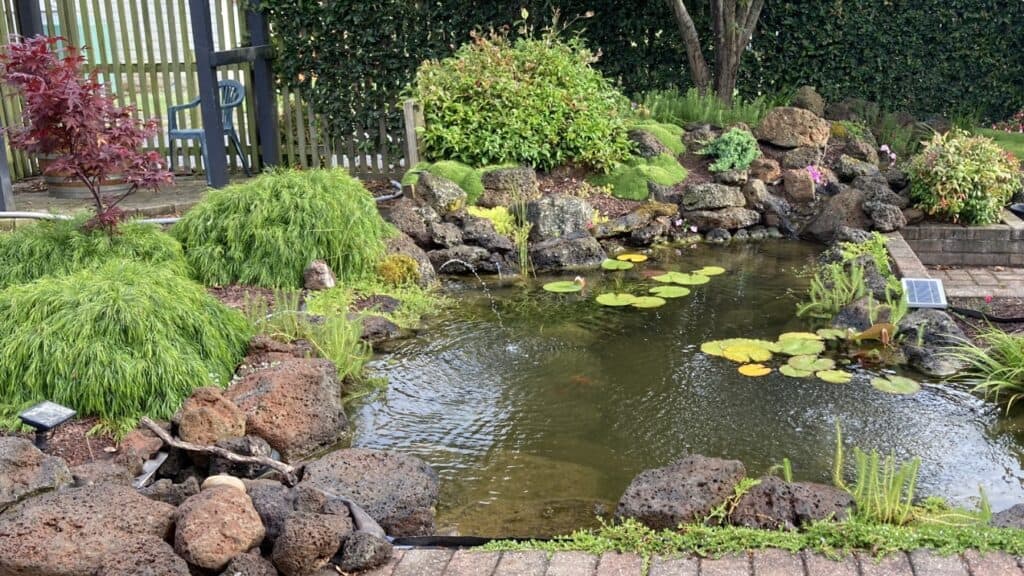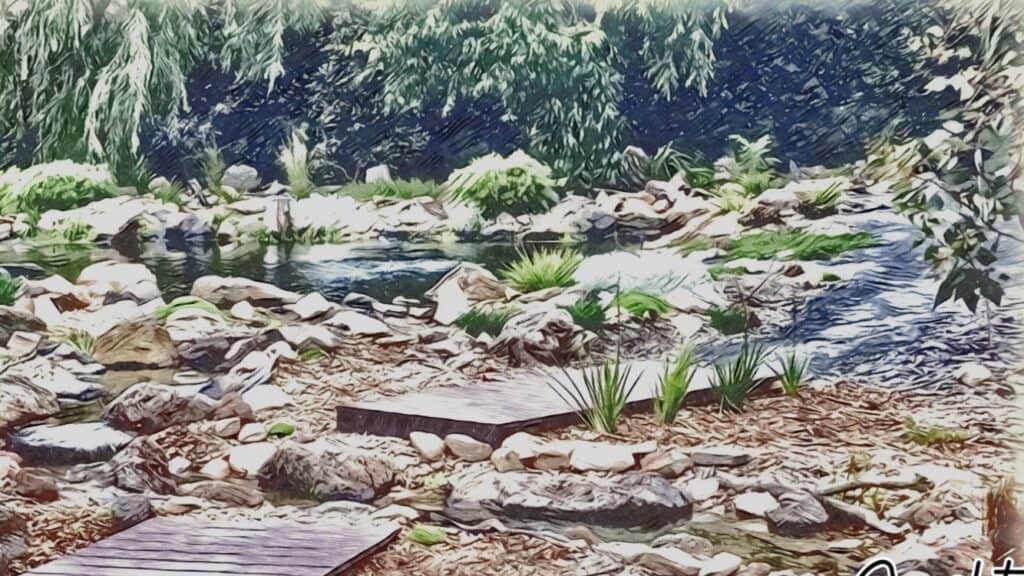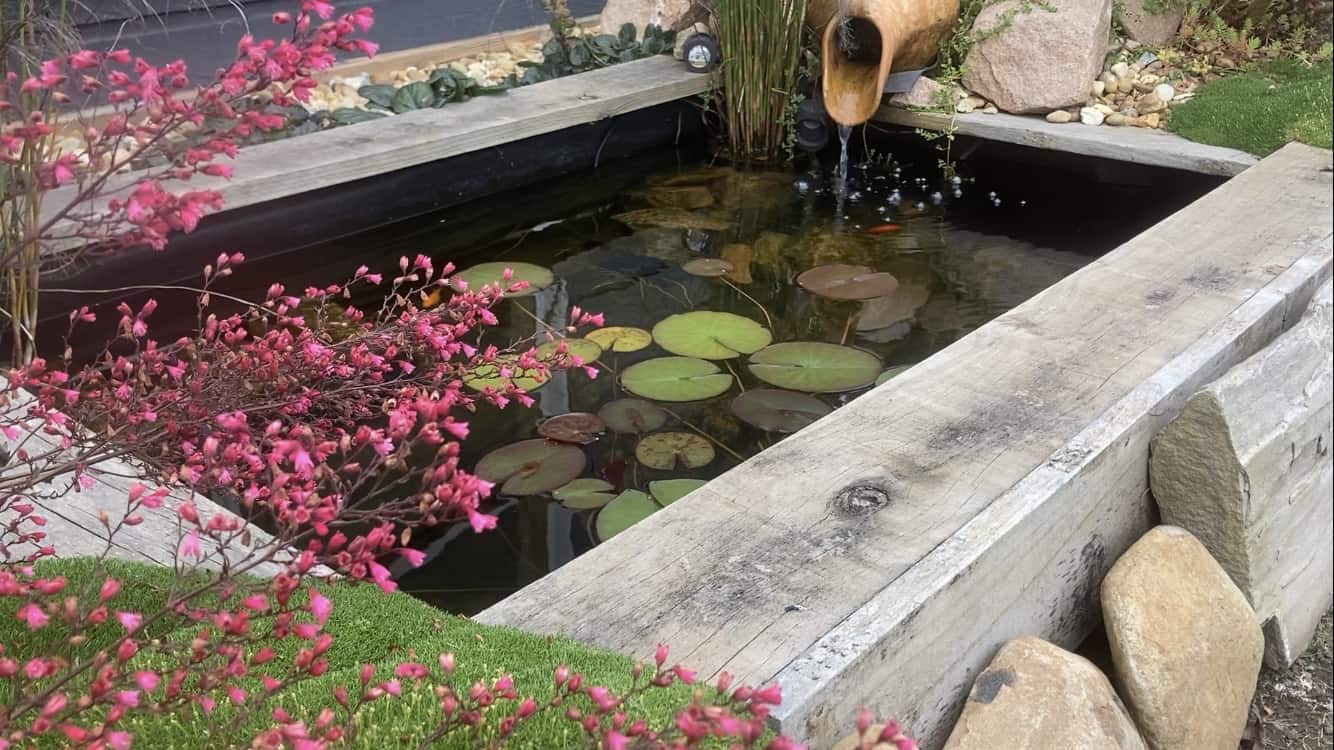So you want to put a fish pond in your yard. But your not sure what you need or where to begin.
Well this guide is for you!
Keeping fish outdoors in a pond is easier than keeping fish in an aquarium. It’s less maintenance.
So let’s dive right in.
Liner or tub
So the first thing you’ll need is a water proof tub or membrane.
For your first pond I recommend you keep it small so you can learn about how the filter works. Then later on once you understand how it all works you can scale it up.
The good news is this will save you a ton of money! Later on in the article I’ll list some good beginner fish that’ll do well in a small pond.
You can pretty much turn any container that’ll hold water into a pond. The cool thing about a container pond is you don’t need to dig a hole.
Of course you can if you would prefer to bury the container. If you want something a little nicer looking you can buy a preformed pond or a flexible rubber liner.
Now I could talk about digging the pond, adding shelves, etc. But this is a quick guide that’ll help get you up and running with your first pond.
If you want a more nitty gritty how to build a pond like the one in the picture below you can read my ultimate guide to building a backyard pond article.
For now as long as you’ve got something that’ll hold water your all set.

Pump
It is possible to have a fish pond with no pump. But you’re a beginner, your first pond is going to have a pump.
The pump is going to circulate the water and that is going to create agitation, which will allow plenty of oxygen to enter the water.
Oxygen is really important to the fish but also the good bacteria’s and organisms that are going to call the pond home.
So for this first pond you’re just going to keep it simple and buy a pump that matches the volume of the pond.
If you’ve got a 500 litre pond you’ll get a 500 litre per hour pump. 100 litre pond a 100 litre per hour pump. You get the idea.
Most of these really small pumps are going to consume very little energy so there’s no need to over think it.
If you do want to try a pond with no pump here’s a video of one I made that you might find helpful.

Need help designing your pond? Looking for affordable pond products?
I’ve assembled a list and helpful links to the products I use when building my ponds.
If you want to check it out click the button below.
Filter
The filter is going to make or break your first pond experience. Without a filter your pond is probably going to go green, or grow loads of algae.
Filtering the water also keeps the water safe for the fish. Now this gets a little “sciencey”. I’ll try and keep it simple.
When the fish breathe they produce ammonia. The problem is ammonia is very bad for fish.
Luckily there are certain bacteria’s that will convert ammonia into less harmful nitrate.
The purpose of the filter to grow these colonies of bacteria that will purify the water.
All these bacteria really need is a wet surface they can cling onto. These types of filters are called biological filters, because the bacteria is alive and it’s doing the filtering.
There are other types of filters, but the biological filter is the most important and it’s all you really “need” for this first pond.
The pump is connected so that water is pumped from pond, through the filter and then returned to the pond.
I like to build my own filters as they are cheaper and I think they work better than the stuff you buy off the shelf.
But more importantly if you learn how to build a filter, you’ll learn more about the bacteria’s and how incredibly easy they can make pond keeping.
And once you understand this process which is called the nitrogen cycle (link to an article I wrote) you’ll be able to build a filter for any sized pond.
I’ve got lots videos on YouTube showing the filters I’ve built and experimented with if you want to learn more.
Of course for this first pond you might just prefer to buy a simple pond/pump filter combo (Amazon affiliate link) from Amazon and that’s fine too.
Fish
For this first pond you’ll want to stick with easy fish. Below are some good hardy pond fish that will survive both warm and cold temperatures.
It’s also important that the fish you choose have enough room to grow. Goldfish grow bigger than most people expect. I personally think you should have at least 1000L (250 gal) pond if you want to keep some goldfish.
Another factor to be aware of is that most fish will breed happily outdoors. So I think it’s a good idea to under stock the pond. If your pond has too many fish the filter will become overwhelmed.
Anyway here’s some good beginner pond fish: All these fish will eat mosquito larvae.
Goldfish and shubunkins: Are very popular and will tolerate a wide range of climates. For your first pond just stick with common goldfish none of the fancy varieties.
These fish can grow to around 30cm (12in) so make sure they have plenty of room. I allow at least 100L (25 gal) per goldfish or shubunkin.
Rice fish (Medaka): These fish are tiny only growing to 4cm (1.6in) and that’s fully grown! Being so small they are perfect for really small ponds.
I keep them in little 100L (25 gal) ponds. These fish are super tough! They will tolerate wide fluctuations in temperature. They come in loads of different colours.
To start with just add 10 fish per 100 litres (25 gal), they will breed in summer.
White Cloud Mountain minnows: Another small fish. These will grow to around 5cm (2in). White clouds are another tough fish!
They are really active and dart around quite quickly. I think they are a really pretty fish although it’s hard to see how pretty they are when vowing from above.
The goldfish, shububkins and rice fish are quite easy to see as they are so colourful.
White clouds will also breed a lot over summer. Like the rice fish you can stock them at around 10 fish per 100 litres (25gal).
Food
The beauty of keeping fish outside in a pond is that you don’t really need to worry about feeding them.
Of course most people can’t resist and really enjoy feeding their fish. Problem is most people will over feed them.
When you over feed you add extra waste and nutrients to the pond. That can lead to problems with water quality and clarity.
There’s no substitute for live foods that the fish forage themselves.
The less inputs you can put into the pond the easier to maintain and the healthier the pond.
If there’s an abundance of food available the fish will breed and the young will survive and grow. If there’s not enough food the youngsters won’t make it.
I like to allow the pond to find the right amount of fish. But I try not to add any food. Just what nature provides.
Plants
Of course plants in and around the pond make it look better, but they also provide plenty of other benefits.
Aquatic plants can help oxygenate the water and even the gravel or substrate they are planted in.
They provide hiding areas to keep the fish safe from predators. Not to mention keeping baby fish safe from bigger fish.
Plantings in and around can add shade to the pond which is quite important during summer. Many cold water species that we like to keep in outdoor ponds don’t like their water too warm.
Plant selection is a personal preference. I like to chose slower growing less invasive varieties. That’s because I’m a hands off sort of guy and I don’t want to be always pruning and maintaining the plants.
However there is a benefit to using fast growing plants if you are willing to maintain them. Quick growing plants will pull more nutrients from the water.
If you’ve got a liner pond just avoid anything with a super aggressive root system that could potentially penetrate the liner.
Other than that use your imagination and try different things. If you want some ideas the video below shows most of my favourites.
Maintenance
I keep adding more ponds to my yard because I find them really low maintenance for heaps of enjoyment.
That said if this is your first pond it’s going to be an experiment. You’ll see what you like and what you don’t.
You’ll tweak things to find out what works for you. Once you find that sweet spot there should be very little maintenance.
If you want to learn more about building and maintaining a pond follow along with me on YouTube and we can keep learning together.

